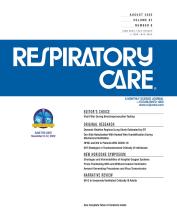PEEP titration in ARDS is still a challenge at the bedside, applied with varying techniques such as PEEP/FIO2 table, lowest-distending pressure, best respiratory-system compliance during decremental PEEP trials, PEEP titration by the low inflection point of pressure-volume curve, PEEP titration by electrical impedance tomography (EIT), PEEP titration by computed tomography (CT), and PEEP titration by transpulmonary end-expiratory pressure. Different gas exchange and lung mechanics can be achieved during experimental and clinical studies, but the impact on hard, clinically meaningful outcomes remains to be determined.1
EIT is a promising, noninvasive, radiation-free, continuous bedside imaging technique that measures the distribution of tidal variations in air content inside the lungs during assist-controlled ventilation.2 He and colleagues3 analyzed 117 subjects with ARDS receiving mechanical ventilation randomly assigned to EIT (n = 61; PEEP adjusted based on ventilation distribution) or control group (n = 56; low PEEP/FIO2 table). The primary outcome was 28-d mortality. They observed no statistically significant difference in the value of PEEP between the EIT versus the control group. There was no significant difference in mortality rate (21% vs 27%, EIT vs control, P = .63), ICU length of stay (13.0 d vs 10.0 d, P = .17), and ventilator-free days (14.0 vs 19.0, P = .55) between the 2 groups. However, significantly lower ΔD1-Sequential Organ Failure Assessment (SOFA) and ΔD2-SOFA were found in EIT group (P < .001) in a post hoc comparison.
Hsu and colleagues4 randomized 87 subjects to either EIT-PEEP titration group (n = 42) or pressure-volume (PV) PEEP titration group (n = 45). The authors observed that PEEP was significantly higher …
Correspondence: Carmen S V Barbas, Pulmonary Division, Heart Institute – INCOR, FMUSP, University of São Paulo, São Paulo, Brazil; and Adult Intensive Care, Albert Einstein Hospital, São Paulo, Brazil. E-mail: carmen.barbas{at}gmail.com







